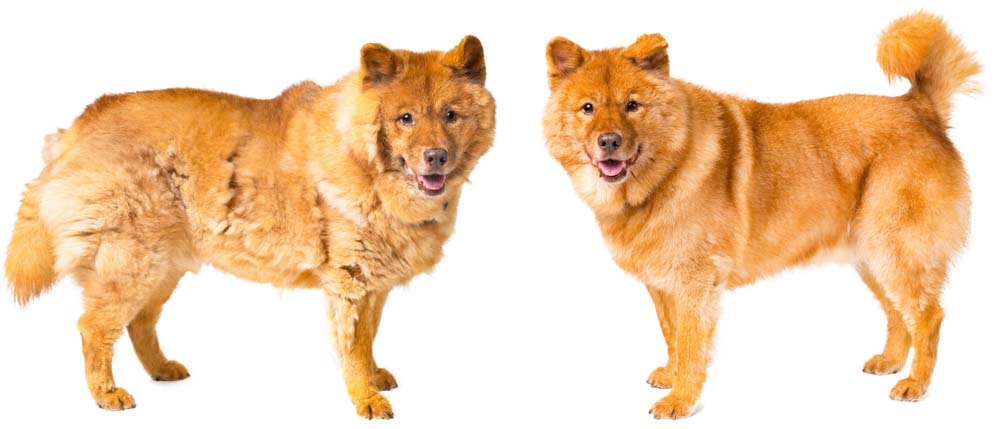
Table of Contents
- 9 Ways You Can Improve Your Dog’s Skin and Coat Health
- 1. Feed them a Better-Quality Food
- 2. Supplement Their Diet with Omega Fatty Acids
- 3. Eliminate Junk Food (This Includes Unhealthy Treats)
- 4. Create and Maintain a Regular Grooming Schedule
- 5. Bathe Your Dog, But Do it Sparingly
- 6. Do Not Use Human Products on Your Dog’s Coat
- 7. Treat the Source of Allergies Rather Than Just the Symptoms
- 8. Massage Your Dog
- 9. Address Emotional Licking or Scratching Before it Gets Out of Control
Your dog’s skin and coat obviously serve important functions such as providing warmth, offering protection, regulating body temperature, and providing and enhancing sensation. Skin and coat can both also serve as a great general indicator of your dog’s overall health. So let's talk about not only keeping it in tip-top shape but also improving the condition of dogs' skin and coat health.
The Dog's Skin and Coat
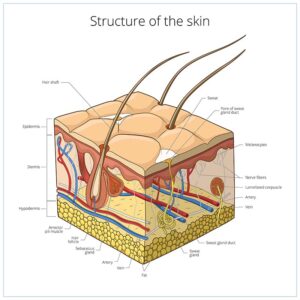 Just as our skin serves to protect us against environmental damage from toxins, bacteria, weather elements, etc., our dog’s skin does the same. It also helps to maintain body temperature, allow for feelings of sensation, and prevent fluid loss.
Just as our skin serves to protect us against environmental damage from toxins, bacteria, weather elements, etc., our dog’s skin does the same. It also helps to maintain body temperature, allow for feelings of sensation, and prevent fluid loss.
This protection is afforded by the dog's skin’s collaboration with other connected structures, such as the underlying fat layer, the hair, and the blood vessels. Unfortunately, because the skin functions with so many “other parts” in the mix, it often means that when our dogs have signs of skin problems, these other structures can suffer as well, so it’s important to treat these canine skin issues as soon as they occur.
Like the skin, our dog’s coat serves to enhance feelings of sensation and maintain a healthy body temperature, but again, the coat also relies on other underlying structures to perform its duty. For example, the hair of your dog’s coat sits in a hair follicle that lies under the epidermis. This follicle ensures that the hair is supported and anchored into the skin. If the hair that sits in this follicle consistently grows inward, it can lead to an infection of the follicle.
Reasons Why Your Dog May Have Skin or Coat Problems
There are so many reasons why your dog may be experiencing coat or skin problems or one of the more known skin conditions. It can often be difficult to distinguish the cause of a skin or coat problem in dogs because of the complex interaction between the different “layers” of their skin and coat system. That said, some of the most common causes of skin and coat problems in dogs include:
- Malnutrition
- Eating food that contains poor-quality ingredients
- Naturally dry skin
- Naturally oily skin
- A lack of omega fatty acids
- A failure to properly groom your dog’s coat
- Over-bathing or under-bathing your dog
- Using products on a dog’s skin or coat that are designed for human use
- Allergies
- Emotional/Psychological Concerns
Being aware of these causes makes it easier to look into the source and try to eliminate the issue from there instead of attempting to treat the symptoms on the surface alone.
ALSO READ: How to Use Coconut Oil for Dog Skin Problems
9 Ways You Can Improve Your Dog’s Skin and Coat Health
1. Feed them a Better-Quality Food
One of the first things that you can do to improve your dog’s skin and coat health is to take a look at the diet that you are feeding. If that diet is filled with plenty of fillers, poor-quality protein, more artificial ingredients than you can pronounce, and not very much nutrition at all, you may have found your culprit without going any further.
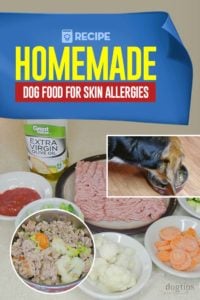 Think of how dull your skin and hair would be if you were to eat a diet of fast food all day, every day. While you would presumably be able to survive on this diet, it’s certainly not doing you any favors and is likely neglecting crucial vitamins and minerals that are necessary for skin and hair health.
Think of how dull your skin and hair would be if you were to eat a diet of fast food all day, every day. While you would presumably be able to survive on this diet, it’s certainly not doing you any favors and is likely neglecting crucial vitamins and minerals that are necessary for skin and hair health.
Also, keep in mind that you don’t have to spend a fortune each month on dog food to get good quality food. Good food is about the ingredients and the balance of those ingredients in the food. Learn to read the label on your dog’s bag of food and find a food that offers more than that, and you’re making a step in the right direction.
2. Supplement Their Diet with Omega Fatty Acids
Omega fatty acids are of great benefit to us all because of their anti-inflammatory properties. When incorporated into a diet plan, omega-3 and -6 fatty acids feed the body’s cells with healthy nutrients that they require to create healthy cell membranes. In people, this results in better and younger-looking skin, and in our dogs, it means skin that is better able to do its job and a coat that looks healthier overall.
3. Eliminate Junk Food (This Includes Unhealthy Treats)
Just like us, our dogs require a balanced and healthy diet to have a body that performs at an optimal level. When we load our dog’s diet up on junk – foods that have little nutritional value, like treats with plenty of artificial ingredients – we are not providing the body with the nutrients it requires to maintain healthy function.
A diet that's high in treats and low in quality nutrients often results in a lack of the necessary vitamins and minerals needed for skin and coat health, including EPA, DHA, vitamin E, vitamin C, and biotin. Dogs are exposed to vitamin deficiencies and other potential health issues that will often be tied to dogs' skin and coat health.
4. Create and Maintain a Regular Grooming Schedule
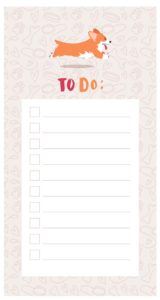 A regular grooming schedule is a critical part of ensuring that your canine has and maintains a healthy coat. Brushing your dog regularly (even if they are a short-haired breed) does more than make their coat look presentable. Brushing also helps to:
A regular grooming schedule is a critical part of ensuring that your canine has and maintains a healthy coat. Brushing your dog regularly (even if they are a short-haired breed) does more than make their coat look presentable. Brushing also helps to:
- to remove any debris buildup
- to identify any areas of concern
- to notice any parasites
- to stimulate oil production by the hair follicles
The frequency with which you should brush your dog depends on their breed and coat type, but a couple of brushing sessions a week will go a long way in keeping your pup's coat looking good.
5. Bathe Your Dog, But Do it Sparingly
Bathing your dog is another way to keep your dog’s coat and skin healthy by eliminating dirt and debris buildup. Bathing also helps to keep skin hydrated and supple. However, bathing too much or over-bathing a dog can produce the opposite result, too.
When combined with regular grooming, most dogs require a bath only every two to six months, depending on their lifestyle. Over-bathing your dog will generally lead to drying of the skin, which causes the oil glands to go into overdrive, and your pet will wind up with a very oily coat at the least.
6. Do Not Use Human Products on Your Dog’s Coat
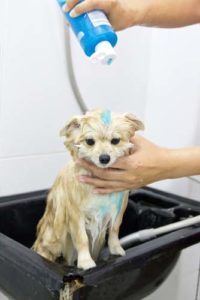 While we are talking about grooming and bathing, always be sure to use canine-formulated products when caring for your dog’s skin and coat. If you are currently using human-formulated products, it may be the reason that your dog has a dull coat and itchy skin.
While we are talking about grooming and bathing, always be sure to use canine-formulated products when caring for your dog’s skin and coat. If you are currently using human-formulated products, it may be the reason that your dog has a dull coat and itchy skin.
The natural pH of your dog’s skin (6.5 to 7.5) is not the same pH as the natural pH of your skin (5.5).
Compared to our skin, our dogs have a neutral pH level, whereas we have a much more acidic pH level. Beauty and grooming products are formulated to help to maintain a natural pH of the skin so that a shampoo formulated for human use is going to have a more acidic pH and if used on your dog, it will create a good degree of irritation and drying.
If your dog has skin and coat issues, try using a gentle dog shampoo that is free from artificial ingredients and additives the next time you give them a bath; it certainly won’t hurt.
7. Treat the Source of Allergies Rather Than Just the Symptoms
Often, our dogs exhibit skin and coat problems when they are experiencing allergy symptoms. Two of the most common symptoms of allergies in dogs are dry and itchy skin, and many pet parents treat those symptoms with creams, sprays, lotions, oils, and shampoos, but when the symptoms have disappeared, they stop treatment.
The problem with this is that because the allergy itself has not been identified and is not being treated, the symptoms are going to return eventually, and you're going to be back to using grooming products again if you haven't gotten to the source of the issue. Sometimes treating a skin issue such as itchy skin, for example, is as easy as switching to a different itchy skin diet or even trying a homemade recipe.
When your dog has skin and coat symptoms that appear to be related to allergies, it’s important to do more than just treat the symptoms alone. Take your pooch to their veterinarian and have them undergo allergy testing. Once you determine what they are allergic to you will be able to prevent future skin and coat problems by avoiding it altogether or through regular preventative medication.
8. Massage Your Dog
 Regular pet massage isn’t just a great stress relief for you and your dog; it also has many physical benefits that can change the appearance and health of your dog’s skin and coat (and other organs, too!). Giving your dog a massage is extremely beneficial on all fronts.
Regular pet massage isn’t just a great stress relief for you and your dog; it also has many physical benefits that can change the appearance and health of your dog’s skin and coat (and other organs, too!). Giving your dog a massage is extremely beneficial on all fronts.
When we receive a message, we increase blood flow to various areas of our body, including the skin. As the flow of blood increases, more nutrients are carried to these areas, which helps reduce pain and inflammation. This improved blood flow also helps the immune system function by promoting the flush of toxins from the body through the bloodstream. Combined, these exact same pet massage benefits leave our dogs looking and feeling healthier, too.
If you’re unsure of how to begin with canine massage, please don’t just jump in feet first – you wouldn’t do that with human massage, and it’s not advised for canine massage either. Instead, we recommend that you at least look at this guide or, better yet, look into local canine massage services or classes that can help guide you through the process. They are not as difficult to find as it may sound and they can really improve your dog’s quality of life, particularly if your pup is older or ailing.
9. Address Emotional Licking or Scratching Before it Gets Out of Control
Lastly, some dogs will exhibit physical symptoms of poor health as a result of emotionally driven behaviors. For example, anxious dogs often chew at their paws as a nervous habit. This chewing can quickly lead to open sores and infection which creates a bigger problem.
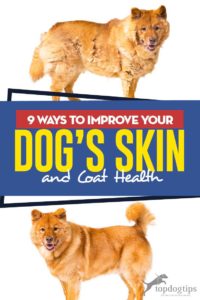 Rather than brushing off your dog’s unusual behaviors, we recommend analyzing your and your dog's current lifestyle and any changes that you have made that could be contributing to your pet's behavior.
Rather than brushing off your dog’s unusual behaviors, we recommend analyzing your and your dog's current lifestyle and any changes that you have made that could be contributing to your pet's behavior.
If you are at a loss for why your dog may be taking their emotional stress out by self-harming or with neurotic behaviors, we recommend consulting with your vet or a canine behavioral trainer about how your dog is behaving.
A professional trainer will be able to help you to understand these behaviors as well as teach you how you can help your dog to overcome them.
READ NEXT: The Best Dog Food for Sensitive Skin


